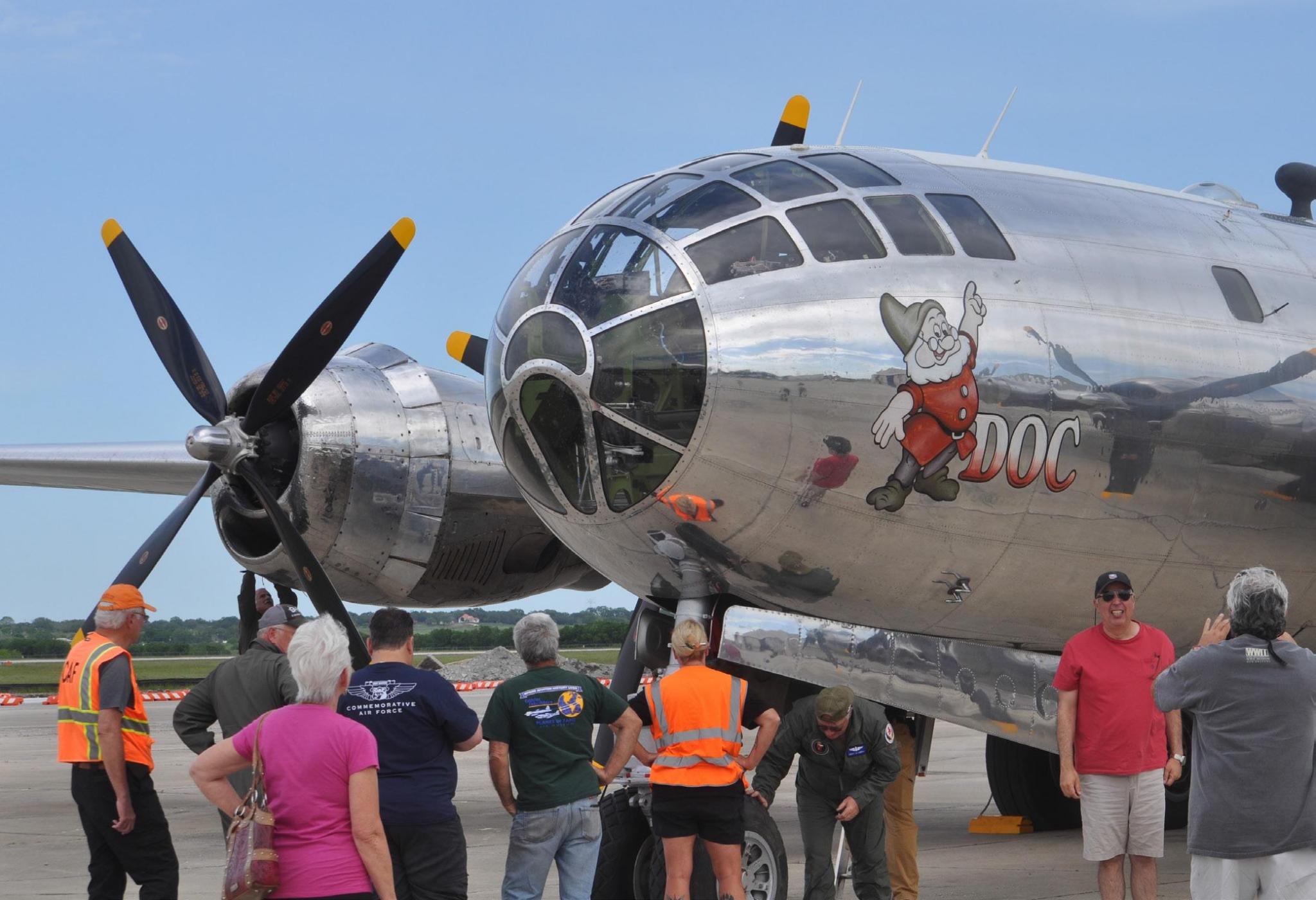
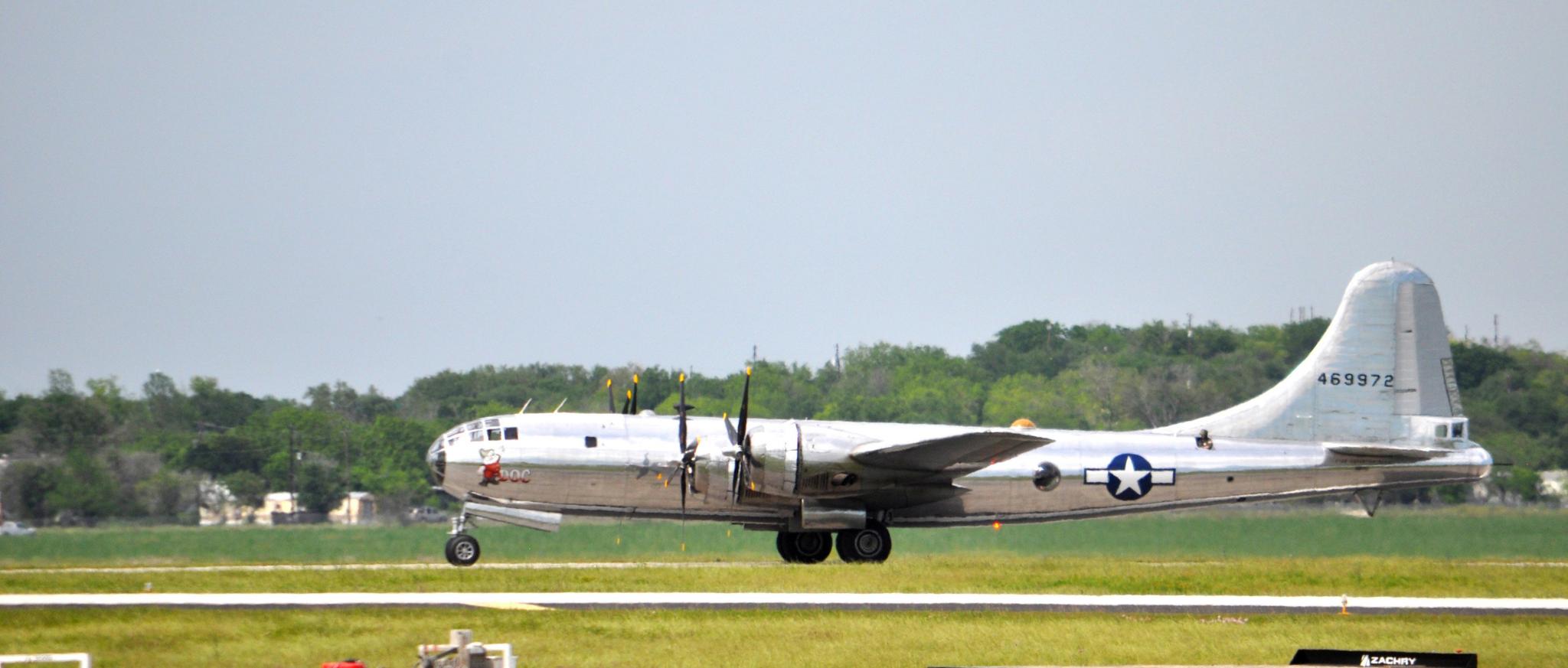
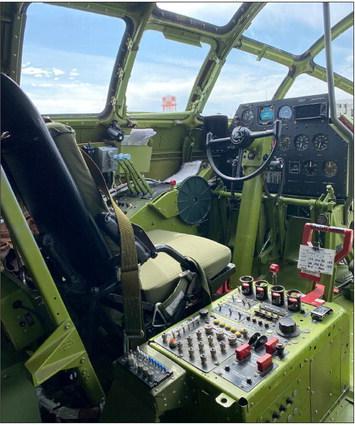
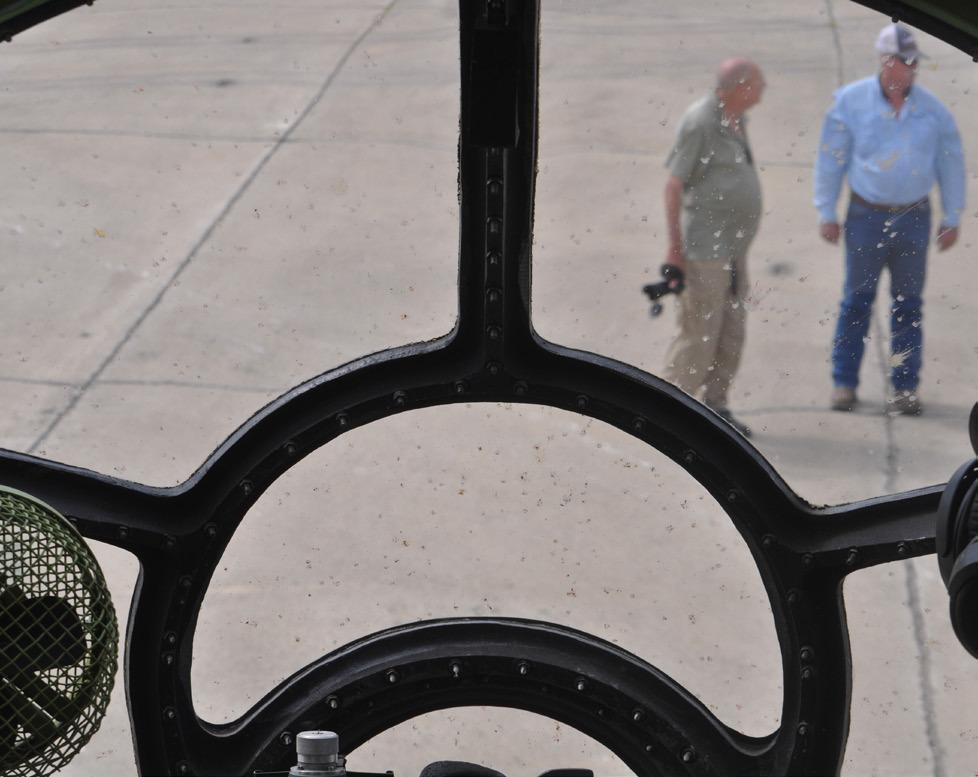
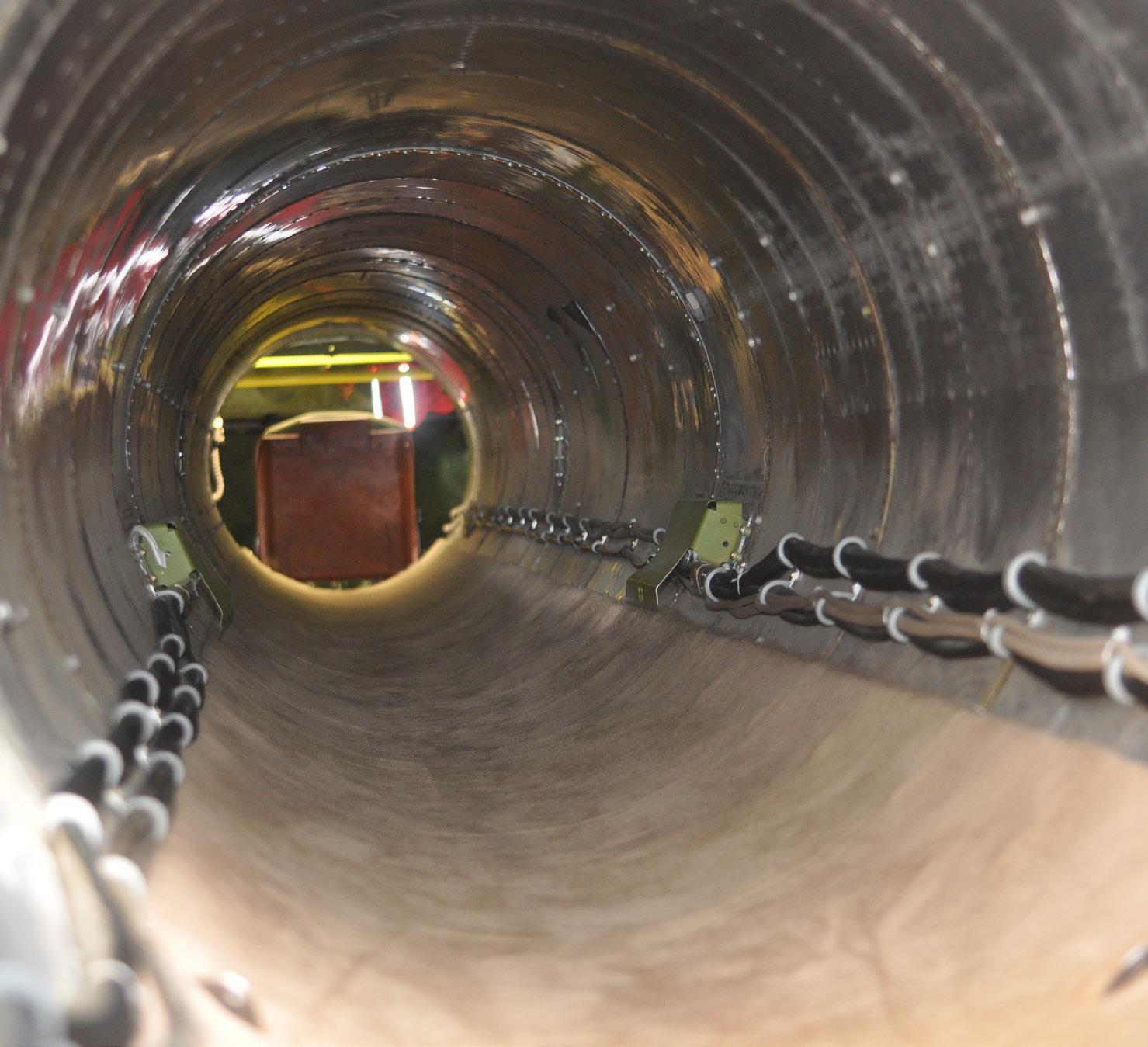
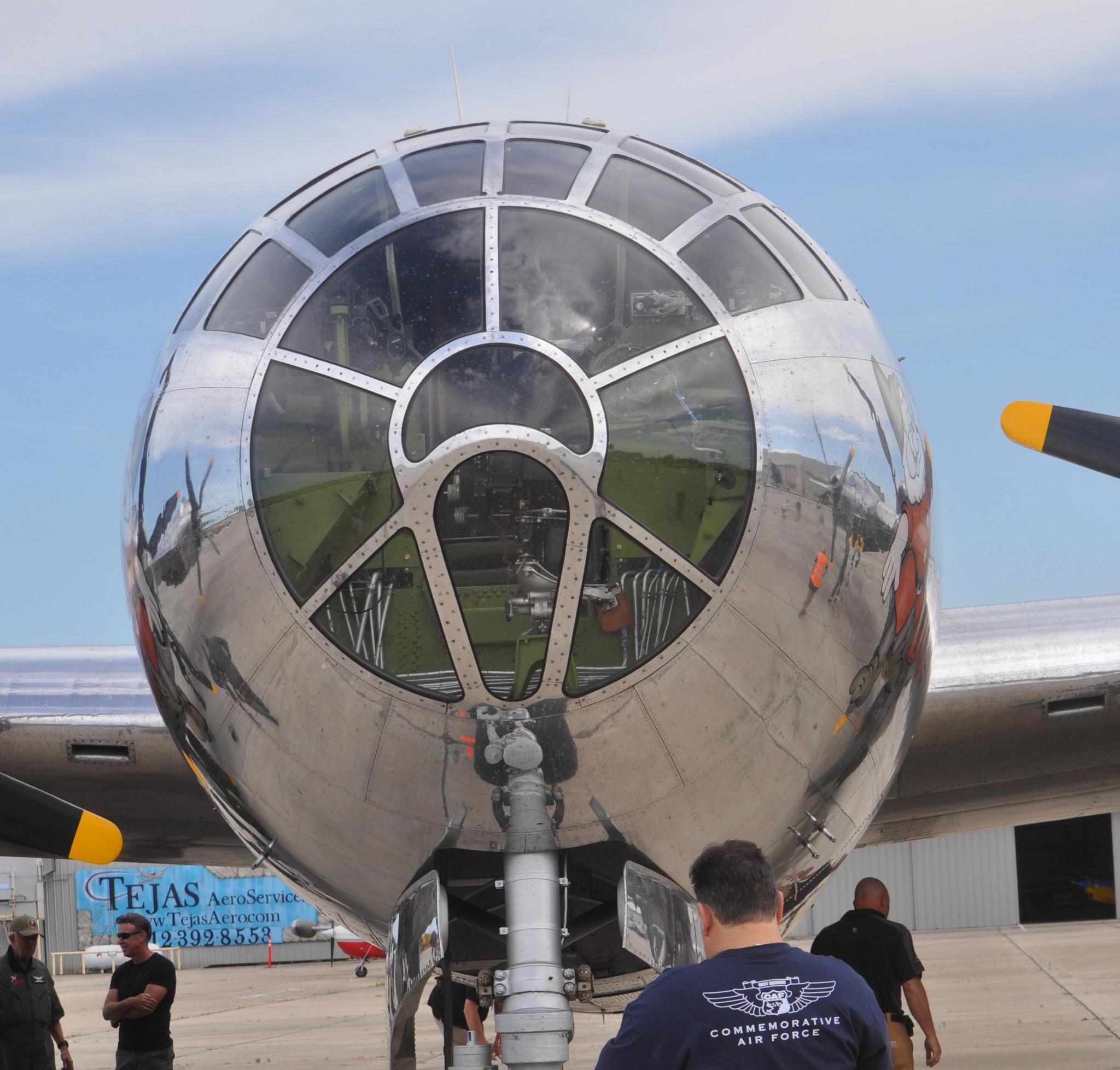
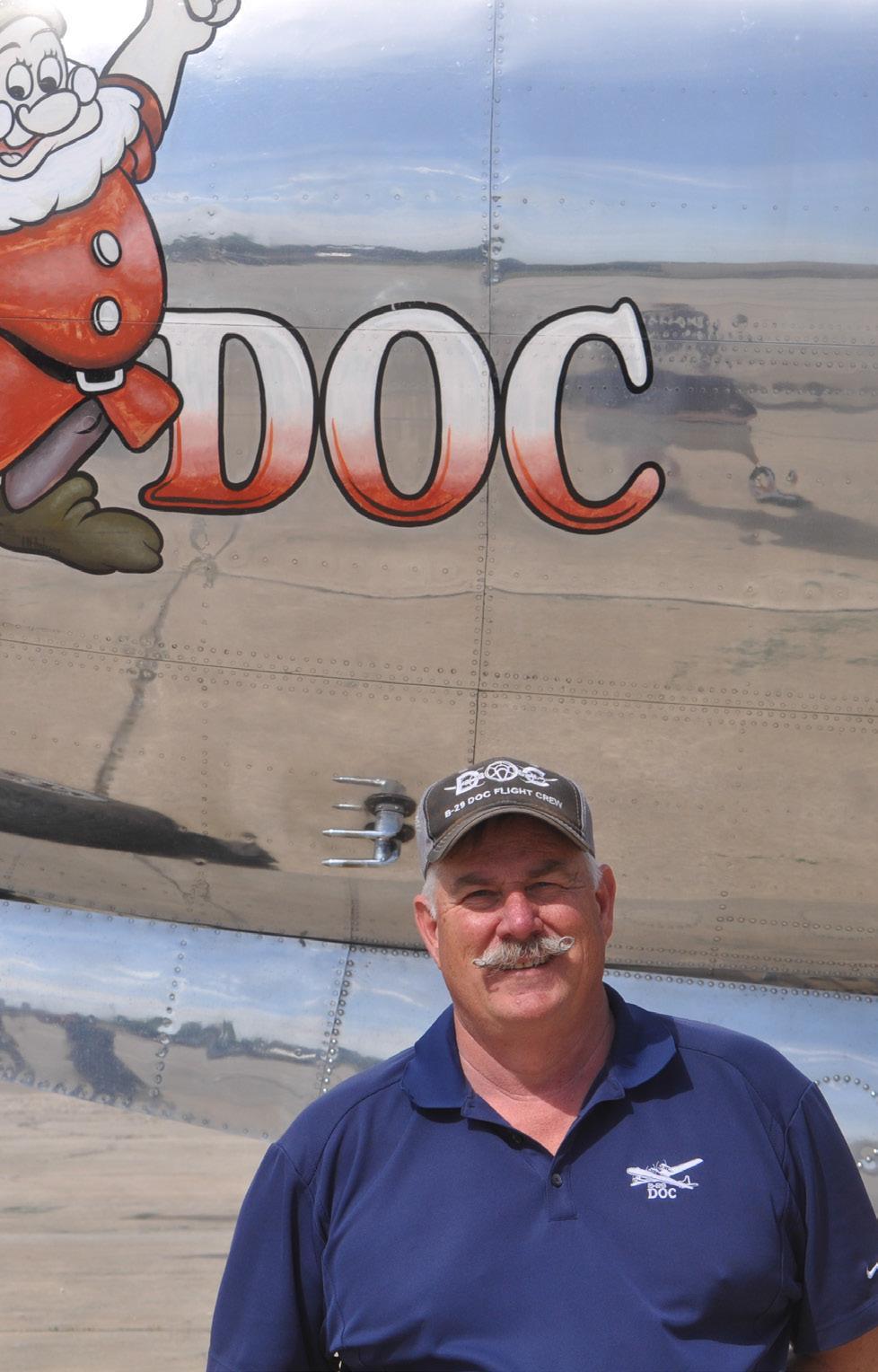
Pictured are interior and exterior views of ‘Doc,’ the B-29 Superfortress now at the San Marcos Regional Airport through Friday for tours and rides. Above, Pilot and U.S. Air Force veteran Mark Novak stands in front of the fuselage of the airplane he takes across country.
Daily Record photos by Shannon West
Doc Arrives
The crowd of WWII and plane enthusiasts gawked as “Doc,” the larger than life B-29 Superfortress, flew into the San Marcos Regional Airport Monday for what is billed as the Doc History Restored Tour.
The aircraft touched down from clear skies and the care for this 79-year-old aircraft was evident the minute it landed–when the entire crew hopped to the ground and immediately began shining and polishing the silver bird.
The airplane is under the wing of Doc’s Friends, Inc., a 501c3 non-profit board which manages its operation and tour appearances meant to commemorate the “greatest generation,” Doc’s Friends Executive Director and General Manager Josh Wells said.
While in San Marcos, Doc is the special guest of the Commemorative Air Force Central Texas Wing.
According to Wells, Doc is named after one of the original characters from Walt Disney’s iconic film, “Snow White and the Seven Dwarfs,” and sports a mural on the side to honor the bespectacled dwarf.
The airplane was built in 1944 in Wichita, Kansas, one of 1,644 airplanes built by the Boeing Company. Most of the work to construct these airplanes during WWII was by women: the iconic “Rosie the Riveters” as Wells put it.
The war was one year from ending when Doc became airworthy and it was used at that time mostly for training purposes, Wells said..
“In 1956 it was flown to the China Lake Naval Station in the Mojave Desert where it was a missile target for the U.S. Navy for 40 years. Thank goodness, they missed,” Wells said, jokingly.
With Wells to sing Doc’s praises was the airplane’s pilot for this mission, Mark Novak. He said that during those long ago desert maneuvers, one worker took a liking to Doc and a few other aircrafts, so he pulled 10 over to the fence and “eight of those 10 are still left,” Novak said.
Wells said that Doc was rescued once again in the mid-1980s and, due to its massive size, was shipped to Wichita for restoration in seven flatbed trailers.
“It took 16 years and 450,000 volunteer hours to put it back together,” Wells said.
As far as the financial investment, it is hard to give an exact number, but Wells estimated that it’s well over $30 million.
To give an idea of Doc’s size, Wells said that it is 99 feet long with a 142 foot wingspan and weighs approximately 90,000 pounds.
“It burns 450 gallons of Avgas an hour. It costs us about $8,000 to $10,000 per flight hour to operate the airplane,” Wells said. “ For every hour we fly the plane, it’s about 100 hours of maintenance.”
For any pilot, flying a plane like this might appear to be a massive undertaking, but Novak said he is no stranger to flying aircrafts of all types.
“I was an Air Force pilot. I flew four different airplanes: the Learjet, the B-1 bomber, the gliders at the academy and then I retired flying the KC135,” Novak said. “After I retired from the Air Force, I was looking for something to do and the Commemorative Air Force has one (B-29) called Fifi, just like this,” Novak said, as he pointed at Doc. He was able to fly Fifi which set him up perfectly for what was to come. Novak said he lives near Wichita, where Doc is based, so when Doc’s Friends were looking for pilots, it was “Kismet.”
According to Wells, Doc has a crew of six that operate the plane. There is a pilot, co-pilot and flight engineer.
“Really it’s the flight engineer’s airplane. The pilot has a little bit of control of the throttles up there during take off and landing, but primarily the flight engineer sits here and controls all of the throttles, propellers and engines,” Wells said.
Flying Doc which sports little wiggle room inside is a team effort.
“When I sit in the seat, I cannot even see the inboard engines. They’re too far back,” Novak said. “So when I need to move the engines, I just tell my engineer. The guys in the back can tell me if it’s on fire or if there’s smoke.”
Similarly, there is little leg room inside for the crew. There are only 11 seats. The crew gets back and forth through a tunnel that runs from the front of the aircraft to the back and is about two and a half feet in diameter. The plane is only pressurized up front and in the tail. Pressurizing the tunnels would have required that the airplane “be full of insulation and ductwork, so the opening wouldn’t be that big,” Wells said. One can only wonder that few claustrophobic service personnel could have been members of its original crew.
Wells said Doc’s stay in San Marcos includes public opportunities to tour the outside and inside and for plane enthusiasts, one can pay to take a flight and experience what it is like to ride this massive war bird.
Ride tickets may cost from $600 to $1,500 depending on the seat. It’s approximately a 90-minute experience; 30 minutes of which are spent going through engine startups. Passengers are fitted with headsets and immersed in the crew experience. Then there is a 30-minute flight and the rest of the time, guests may explore the craft. Cockpit and ground tours are $10 a person and $20 for a family of any size.
“We are able to use the movement of the aircraft and the ride flight program as a way to generate revenue, so we’re not always out as a non-profit asking for donations and those types of things.” Wells said, adding that his organization is able to pay the expenses by “operating it as a business.”
“We’re thrilled to be guests of the CAF Central Texas Wing. CAF has a great mission, and especially the Central Texas Wing here in San Marcos which is a great gem,” Wells said. According to their website, the CAF Central Texas Wing Museum contains seven aircrafts for which the wing has restoration and maintenance responsibilities: the Douglas Sktrain C-47 That’s All Brother, the NAA AT-6 Texan, Beech C-45 Expeditor Lone Star Lady, a Cessna U-3A Administrator, a Vultee BT-13 Valiant, the NAA B-25J Yellow Rose, and a very-rare flying Bell P-39Q Airacobra Miss Connie.
Ground and flight deck tours are available today from noon to 4 p.m. following morning rides flights, and again Thursday, April 20, from 10 a.m. to 4 p.m., with evening ride flights.
Tickets for ground tours will be available at the gate.
The public entrance for the event is at the CAF Central Texas Wing Hangar, 1841 Airport Drive, Building 2249, San Marcos, TX, 78666. For information about the CAF Central Texas Wing, visit www.centraltexaswing. org.











